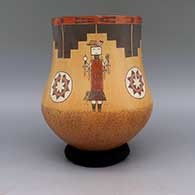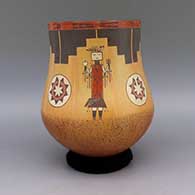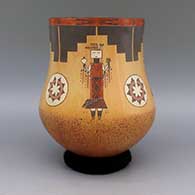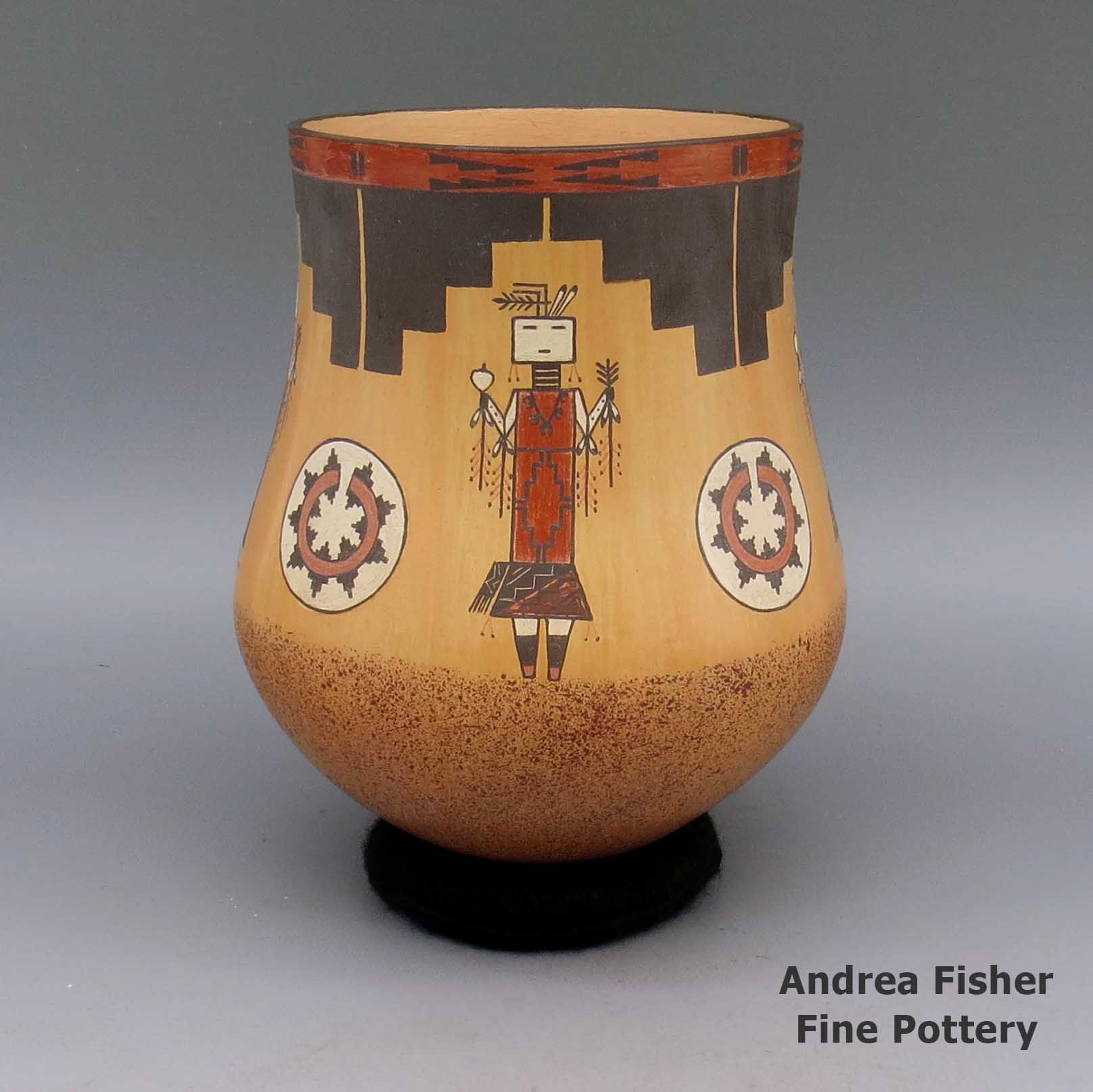
Dineh
$ 1700
hwnv2g292
Polychrome jar with yei, medallion, kiva step, and geometric design
6.25 in L by 6.25 in W by 8.25 in H measurement includes stand
Condition: Very good
Signature: Ida Sahmie “Diné”
Date Created: 2016
Tell me more! Buy this piece!
(505) 986-1234 - www.andreafisherpottery.com - All Rights Reserved
Ida Sahmie
Dineh (Navajo)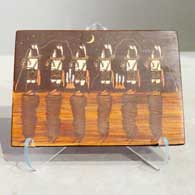
Ida Sahmie was born into a traditional Dineh family near Pine Springs, AZ in 1960. As in many traditional Dineh families, Ida's mother and grandmother began instructing her in how to weave at an early age. By her late teens Ida had decided she didn't have the patience it took to be a serious weaver.
In her mid 20s, Ida met and married Andrew "Louie" Sahmie, a Hopi. She went against tradition and moved to the Hopi reservation after the wedding. Her mother-in-law was Priscilla Namingha, a great-granddaughter of Nampeyo of Hano and a well-known potter in her own right. Ida was almost spellbound in watching Priscilla making pottery and Priscilla encouraged her to work with the clay herself. They worked together for several years before Ida realized she needed to come up with her own design library, a portfolio based on her Dineh heritage. A lot of the designs she uses are based on ancient Dineh sand-painting designs. As sacred images, they must be pictured exactly. Some even require that Ida have a Night Chant ceremony performed before she starts painting in order to make it safe to depict the figures.
Ida's pots are created of Dineh clay, using Hopi techniques and Dineh designs. Bruce McGee of the Indian Art Gallery at the historic Keams Canyon Trading Post was the pottery dealer who jump-started Ida's pottery career. Ida was driving Priscilla to the Trading Post to sell her pottery one day when Priscilla suggested she bring some of her own to sell. Bruce bought most of Ida's pieces and asked for more.
Ida likes to dig her own clay on the Navajo Reservation and uses a mix of natural white and yellow clays to achieve the blended peach-colored body seen on most of her pieces. She also mixes a bit of the white clay with a boiled-down soup of wild spinach to create the softer black slip she uses to paint many of her designs. She fires her pots outdoors, the traditional way, with ash and sand that is mounded over with sheep manure to produce an intense heat. Firing a few pieces can take all day and the weather has to be perfect, the whole time.
At the 2010 Navajo Nation Fair, Ida entered some of her pieces in the Arts and Crafts competition and was awarded the Best of Class and a Second Place Ribbon for her efforts.
Dineh
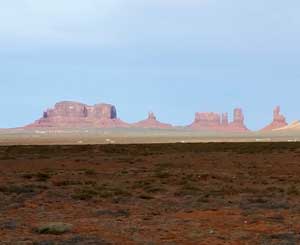
A view in Monument Valley
The Dineh refers to themselves as "Dineh" because the word means "the People" in their language. "Navajo" is a name that was given to them by the early Spanish. Historical and archaeological evidence points to the Dineh people entering the Southwest around 1400 CE. Their oral history still contains stories of that migration as the journey began in eastern Alaska and northwestern Canada centuries after their ancestors made the journey across the Bering Land Bridge from central Asia about 10,000 years ago. They were primarily hunter-gatherers until they came into contact with the Pueblo peoples and learned the basics of survival in this drier climate. Dineh oral history points to a long relationship between the Dineh and the Puebloans as they learned from and traded with each other.
When the Spanish first arrived, the Dineh occupied much of the area between the San Francisco Peaks (in Arizona), Hesperus Mountain and Blanca Peak (in Colorado) and Mount Taylor (in New Mexico). Spanish records indicate they traded bison meat, hides and stone to the Puebloans in exchange for maize and woven cotton goods. It was the Spanish who brought sheep to the New World and the Dineh took to sheep-herding quickly with sheep becoming a form of currency and sign of wealth.
When the Americans arrived in 1846, things began to change. The first fifteen years were marked by broken treaties and increasing raids and animosities on both sides. Finally, Brigadier General James H. Carleton ordered Colonel Kit Carson to round up the Dineh and transport them to Bosque Redondo in eastern New Mexico for internment. Carson succeeded only by engaging in a scorched earth campaign in which his troops swept through Dineh country killing anyone carrying a weapon and destroying any crops, livestock and dwellings they found. Facing starvation and death, the last band of Dineh surrendered at Canyon de Chelly.
Carson's campaign then led straight into "the Long Walk" to Bosque Redondo, a 300-mile trek during which at least 10% of the people died along the way. At Bosque Redondo they discovered the government had not allocated an adequate supply of water, livestock, provisions or firewood to support the 4,000-5,000 people interned there. The Army also did little to protect them from raids by other tribes or by Anglo citizens. The failure was such that the Federal government and the Dineh negotiated a treaty that allowed the people to return to a reservation that was only a shadow of their former territory little more than a couple years after they had left. However, succeeding years have seen additions to the reservation until today it is the largest Native American Reservation in the 48 contiguous states.
Large deposits of uranium were discovered on the Navajo Nation after World War II but the mining that followed ignored basic environmental protection for the workers, waterways and land. The Dineh have made claims of high rates of cancer and lung disease from the environmental contamination but the Federal government has yet to offer comprehensive compensation.
As a semi-nomadic tribe, the Dineh never made much pottery, preferring to use baskets for most storage purposes. They did produce a small amount of pottery for ceremonial uses. Once they were settled on a reservation, pottery began to make more sense. From a beginning making simple wares for colonial estates they transformed their pottery into art. After 1950 Cow Springs brownware began to appear on the market. A trader named Bill Beaver was in Shonto back then, encouraging local potters to "make something different" and the market in the outside world responded positively to those different creations.
Rose Williams is considered the matriarch of modern Dineh pottery. She learned from Grace Barlow (her aunt) and passed her knowledge and experience on to her daughters and many others. Today, most Dineh pottery is heavy, thick-walled and coated with pine pitch (a sealer they also use on many of their baskets). Most Dineh pottery has little in the way of decoration but many pieces have a biyo' (a traditional decorative fillet) around the rim. Unlike Puebloan potters, Dineh potters do not grind up old pot sherds and use them for temper in creating new pottery. Their religion says those pot sherds are infused with the spirits of their ancestors and that forbids the reuse of the material. Similarly, Dineh religion limits Dineh potters to using primarily Dineh carpet designs in the decoration of their pots.
Dineh potters have also created a panoply of folk art, including unfired clay creations called "mud toys." Other Dineh potters, like Christine McHorse, have graduated into the mainstream of American Ceramic Art and easily compete among the finest ceramic artists on Earth.
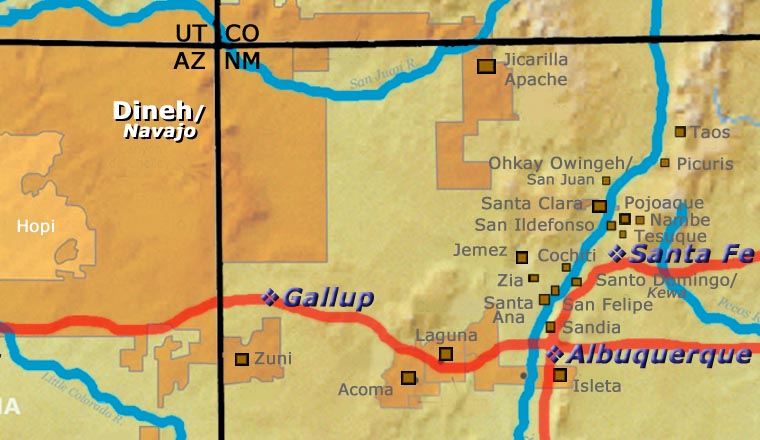
Navajo Nation at Wikipedia
The Dineh people at Wikipedia
Navajo Nation Government official website
Copyright © 1998-2024 by


